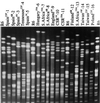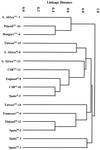Nomenclature of major antimicrobial-resistant clones of Streptococcus pneumoniae defined by the pneumococcal molecular epidemiology network
- PMID: 11427569
- PMCID: PMC88185
- DOI: 10.1128/JCM.39.7.2565-2571.2001
Nomenclature of major antimicrobial-resistant clones of Streptococcus pneumoniae defined by the pneumococcal molecular epidemiology network
Abstract
The emergence of disease caused by penicillin-resistant and multidrug-resistant pneumococci has become a global concern, necessitating the identification of the epidemiological spread of such strains. The Pneumococcal Molecular Epidemiology Network was established in 1997 under the auspices of the International Union of Microbiological Societies with the aim of characterizing, standardizing, naming, and classifying antimicrobial agent-resistant pneumococcal clones. Here we describe the nomenclature for 16 pneumococcal clones that have contributed to the increase in antimicrobial resistance worldwide. Guidelines for the recognition of these clones using molecular typing procedures (pulsed-field gel electrophoresis, BOX-PCR, and multilocus sequence typing) are presented, as are the penicillin-binding profiles and macrolide resistance determinants for the 16 clones. This network can serve as a prototype for the collaboration of scientists in identifying clones of important human pathogens and as a model for the development of other networks.
Figures



References
-
- Allen K D. Penicillin-resistant pneumococci. J Hosp Infect. 1991;17:3–13. - PubMed
-
- Appelbaum P C. Antimicrobial resistance in Streptococcus pneumoniae: an overview. Clin Infect Dis. 1992;15:77–83. - PubMed
-
- Ausubel F M, Brent R, Kingston R E, Moore D D, Seidman J G, Smith J A, Struhl K. Short protocols in molecular biology. New York, N.Y: John Wiley & Sons, Inc.; 1998. pp. 61–63.
-
- Barnes D M, Wittier S, Gilligan P H, Soares S, Tomasz A, Henderson F W. Transmission of multidrug-resistant serotype 23F Streptococcus pneumoniae in group day care: evidence suggesting capsular transformation of the resistant strain in vivo. J Infect Dis. 1995;171:890–896. - PubMed
-
- Camou T, Hortal M, Tomasz A. The apparent importation of penicillin-resistant capsular type 14 Spanish/French clone of Streptococcus pneumoniae into Uruguay in the early 1990s. Microb Drug Resist. 1998;4:219–224. - PubMed
Publication types
MeSH terms
Substances
LinkOut - more resources
Full Text Sources
Other Literature Sources
Medical
Molecular Biology Databases

